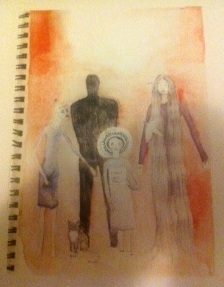
When I first began my social work career at a rape crisis centre, I had the privilege of working alongside a 25-year-old woman called Emma. Emma was referred to me for counselling due to childhood trauma. We engaged in weekly therapy sessions for two years. Over the course of the therapy, Emma revealed a complex and fascinating survival system (DID) that developed due to the horrific sexual abuse she had experienced by a family member from the age of three. Emma gave me permission to use her art and journal entries to help educate others about Dissociative Identity Disorder (DID). The pictures below display Emma’s system, and provide examples of how she began to make connections within her dissociative system.
Emma had been given various diagnoses such as borderline personality disorder, depression, anxiety, PTSD, psychotic episodes, and anorexia and bulimia. Emma reported a range of terrible experiences within the mental health system and felt as though she had not been understood. Emma had not been able to explore her trauma, and survival skills in a safe therapeutic environment. In addition, Emma was taking a multitude of medications and lost track of her specific diagnosis and the side effects of the tablets. When working with Emma it became evident that she was experiencing dissociation. I used a range of therapies such as feminist counselling, emotion focused therapy and a specific “trauma model” by Dr Colin Ross to guide practice. In addition, art and writing became central to Emma’s expression and healing processes. Together, we developed a range of treatment goals that are helpful with complex dissociative disorders.
Stage 1 involved developing trust in the therapeutic relationship, establishing emotional and physical safety, psycho education about co morbidity and dissociation, overcoming dysregulation and slowly allowing Emma to remember the trauma without reliving it and being re-traumatised. Stage 2 involved reconstructing her traumatic narrative, establishing communication within her system, orienting the body to present moment, problem solving and goal setting as a system, and the teaching and practicing of new self soothing skills. Stage 3 involved Emma slowly emerging as a more connected person and system, the practising of safety, self-soothing and relationship building and connecting with the community.
I will attempt to summarise the main elements of her system, but this is only a very brief outline of the amazing survival system that Emma has. Please refer to the pictures attached that Emma designed to express her system.
Emma identifies as being the “host personality”, the one who is “out” the majority of the time. Emily is the spiritual part of Emma who is very creative, protective and sensitive. Together, Emma and Emily created a “nest” in her mind. They go to the nest to “rest and sleep” when the trauma memories became too hard to manage.
Anna (8 years) and is a child part who is aware of some of the abuse that occurred but exists to protect a smaller child part. Sally is 3 or 4 years and is silent unless with Anna. Sally holds most of the abuse memories. During therapy Anna and Sally became less frightened. Adult Emma and her spiritual part provided comfort, and protection to these fearful, and traumatised parts.
D is 12 and 14 years old. This part experiences black and intense depression and can have an abusive voice. D kept the entire system silent during early teenage years. D also has the ability to be aggressive and protect the entire system if under threat. As the therapy progressed D became significantly less angry; D became assertive and protective. Although D still experienced depression that intensity of the depression reduced and Emma had a developed a range of strategies to help manage this.
Minna or M was identified as being 16 year old and the “sad, depressed and suicidal part”. Minna or M often engaged in self-harming behaviours, substance abuse, suicide attempts, and experienced eating disorders. Mina was identified as the shift from internalising emotions to actually “acting out” the anger and rage. Mina is like a rebellious teenager that rejects authority. During the therapy process Emma was able to place her adult self along side this rebellious part to help reduce impulsivity, self harm and to provide acceptance and support. Overall Emma impulsivity and sense of shame significantly reduced.
I spent a challenging and inspirational two years working alongside Emma and her survival system. When our counselling finished Emma had developed safety, and a deep insight into her dissociative system. Emma no longer took a range of medications or identified with the variety of diagnosis that she had been given. Emma can now see that her illness is something to be understood and respected. When I moved interstate, Emma wrote to me on a good bye card saying “ I may have further to go on my journey but I now have trust and respect for myself as a person, I have learnt so much about myself and my sickness and I have grown and healed in ways I could never imagine”.